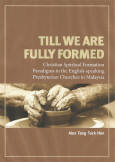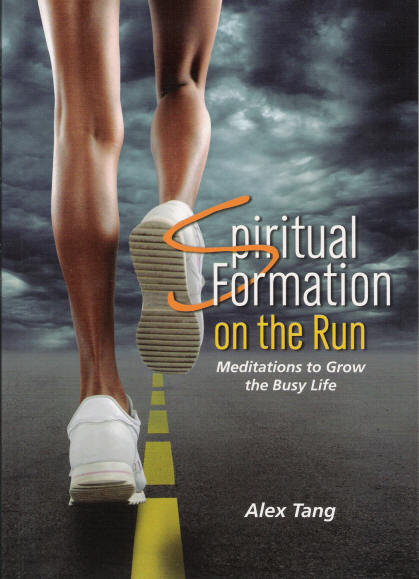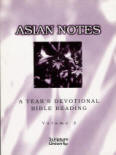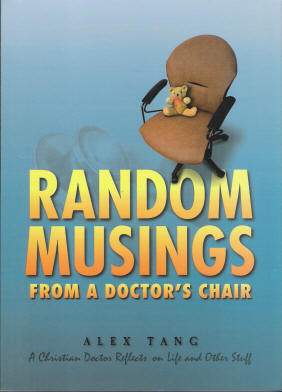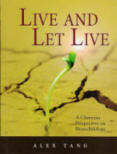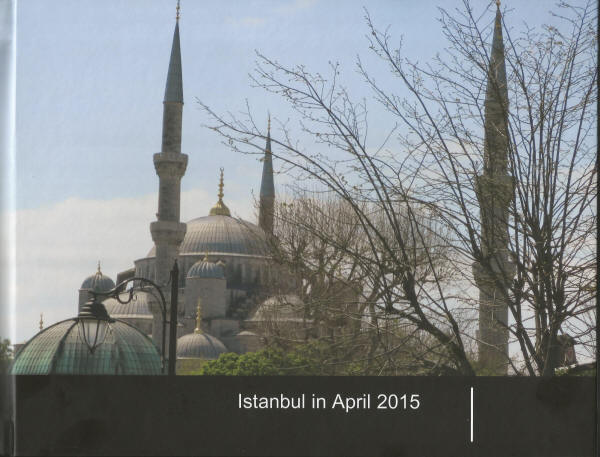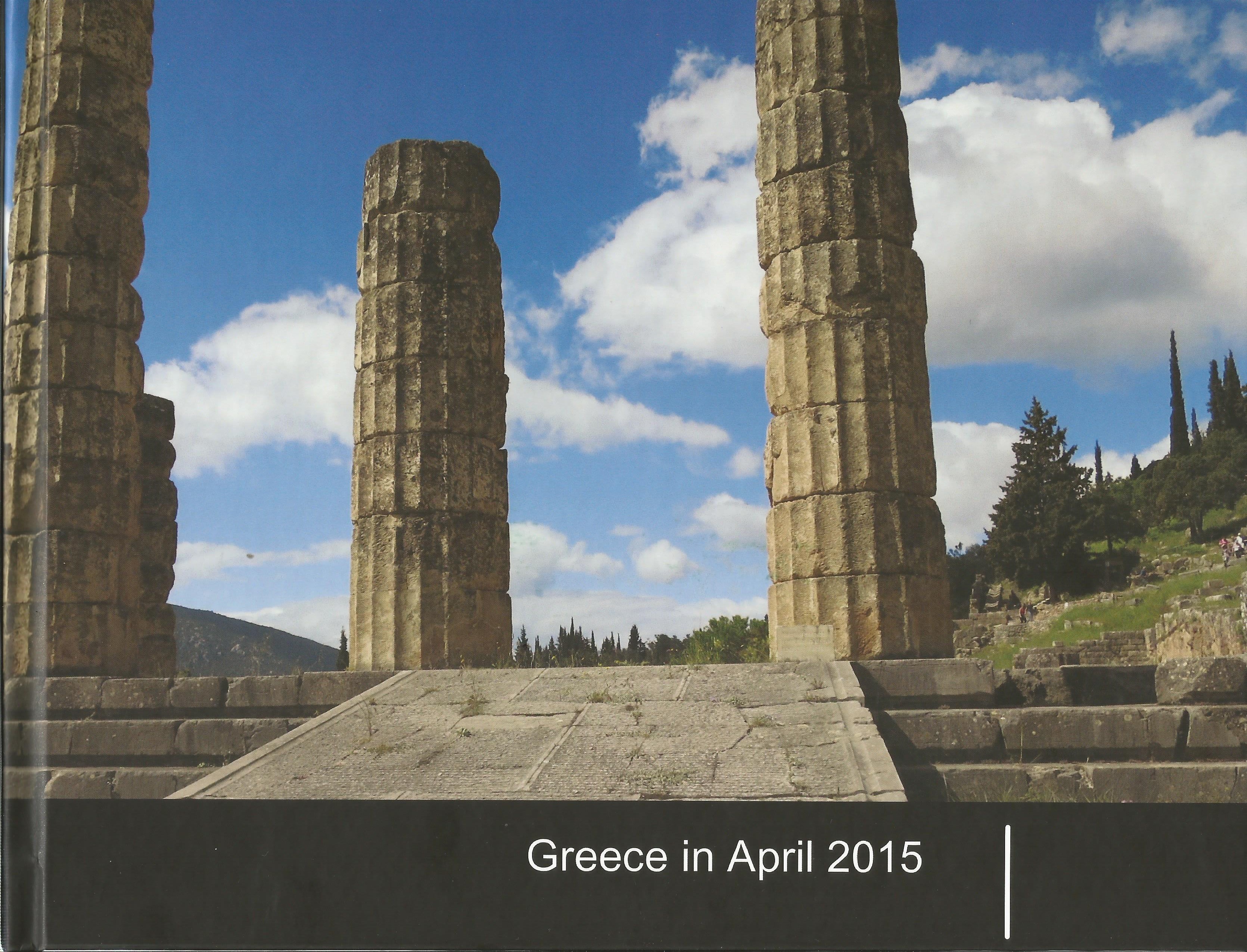Random Musings from a Doctor's Chair
My adventures with God,life and all these stuff.
Tuesday, September 30, 2008
Prayer of the Heart
Prayer of the heart...consists principally of a person placing his mind within the heart and, without speaking with his mouth, but only with inner words spoken in the heart, saying this brief and single prayer: 'Lord Jesus Christ, Son of God, have mercy on me.'
St. Nicodemus of the Holy Mountain
Labels: Desert Fathers and Mothers, Random Musings
Monday, September 29, 2008
How to Cultivate a Love of Reading in Your Child

Francois de Fenelon, a French archbishop and spiritual director declares, “If the riches of the Indies, or the crowns of all the kingdom of Europe, were laid at my feet in exchange for my love of reading, I would spurn them all.” How we wish we will hear such declarations from our children. As parents we want our children to read. We know that reading is a beneficial activity for our children. Unfortunately very few of us actually take the trouble to cultivate the love of reading in our children. We hope that they will develop this love on their own. Very few parents will take the time and effort to help their children to love books. They prefer to spend thousands of dollars on piano lessons, ballet and art appreciation classes, and course fees in specialised teaching that may make their child smarter, yet begrudge spending money in buying books for their children.
Cultivating a love of reading, like all other good habits has to start with intentionality and action plans. Habits develop easily in children, especially bad habits. Parents have to decide that they want to cultivate a love of reading in their children. Once they have this desire, here are five action plans I suggest they implement:
read more
.
Labels: Books and Reading, Parenting
Sunday, September 28, 2008
The Emergence of Emergent
The Emergent movement has stirred passions as a new way of doing church or yet another attempt to wipe the slate clean and start new. But the movement isn't really a movement, not yet, say its supporters. It's still a conversation, one that's taking place in books, articles, and weblogs. Christianity Today and its sister publications participated in the conversation with book reviews and articles. Whether you're a newcomer to the discussion or looking to dive deep, there's plenty of conversation fodder here.
An apocalyptic Brian McLaren strives to reframe Jesus and discipleship.Review by John Wilson, editor of Books & Culture January 16, 2008
Rethinking Church in an Emergent Salon
Rising from the Ashes asks emergent leaders about the impact of alternative worship on the mainline church.Review by Howard A. Snyder January 9, 2008
Phyllis Tickle, Brian McLaren, and others weigh in on worship and evangelism in a plugged-in age.by Becky Garrison, excerpted from Rising from the Ashes: Rethinking Church January 9, 2008
Five Streams of the Emerging Church
Key elements of the most controversial and misunderstood movement in the church today.By Scot McKnight January 19, 2007
Jesus is the truth whether we experience him or not.By Charles Colson with Anne Morse June 1, 2006
The place of absolute truths in a postmodern world—two views.By Brian McLaren and Duane Litfin November 1, 2004
The 'emerging church' movement has generated a lot of excitement but only a handful of congregations. Is it the wave of the future or a passing fancy?By Andy Crouch November 1, 2004
Leading advocate of emergent movement mourned.By Ken Walker May 1, 2005
Christianity Today Reviews A New Kind of Christian and the Sequel
The old kind of Christian is the best hope for church renewal.By Mark Galli posted 04/04/2002
Are Christians prepared for ministry after modernism's failure?By Glenn T. Stanton posted 06/18/2002
Brian McLaren's evolutionary interpretation of the faith promises more than it delivers, but what it delivers is good enough.By Mark Galli posted 04/14/2003
Brian McLaren's sequel to A New Kind of Christian touches other tenets of faith.Reviewed by Cindy Crosby posted 03/26/2003
Books & Culture and the Book that Started It All
Christians in postmodern times .By Brian D. McLaren May/June 2002
Last in a series of responses to Brian McLaren's book, A New Kind of Christian.Tony Jones May/June 2002
Questions for postmodern ChristiansBy Mark Dever March/April 2002
Yes, the church needs to get past modernity's impersonal techniques. But adding the prefix post doesn't solve anything. By Andy Crouch January/February 2002
Leadership's Emergent Wrestling
How did I get here, dancing off-beat, and out of touch?By Ron Benson
Has the Emergent Church Emerged?
When newspapers pick up on a religion story, there's a good chance it's old hat to insiders. So now that the Denver Post and the Press-Enterprise of inland Southern California have written stories on emergent churches, are they really still emerging?By Rob Moll
Why we can and should talk about something else.By Kevin Miller
10 Questions about Postmodern Ministry. By Kevin Miller
A postmodern pastor reaches out to the Mod Squad.By Chris Seay
Reaching people who think negatively about Christianity.An interview with Brian McLaren.
Brian McLaren Says
Passionate, but Not for Mel's Movie
Why The Passion 'outreach' was all hype, and I didn't fall for it.By Brian McLaren
Why efforts to renew the church are often misguided.By Brian McLaren
If worship is for God, why are so many songs about us?By Brian McLaren
The next generation is redefining spiritual formation, community, and mission.By Brian McLaren
.
Labels: Church, Emergent, Emerging Church, Theology
Saturday, September 27, 2008
The Ironic Faith of Emergents
Christianity Today, September, 2008
The Ironic Faith of Emergents
McLaren shows us not only where 'post-evangelicals' are going, but also how they get there.
Scot McKnight posted 9/26/2008 11:11AM
The experience of "ironic faith" is pervasive—though rarely noticed—in the work of McLaren and other emergents. The irony is that they have deconstructed the very thing they were most committed to, and are left with what many call post-evangelicalism.
read more
.
Labels: Church, Emergent, Emerging Church, Theology
Brian McLaren's Emergent Theology
Finally this article appear online. See my earlier post on this.
McLaren Emerging
In his last two books, Brian McLaren presents more clearly than ever his vision of the gospel.
Scot McKnight posted 9/26/2008 11:09AM
I maintain a crucial distinction between two related streams: emergent and the broader emerging movement. Emergent is crystallized in Emergent Village and its leaders Brian McLaren, Tony Jones, and Doug Pagitt. Emerging is a mix of orthodox, missional, evangelical, church-centered, and social justice leaders and lay folk. When I think of this broader emerging movement, I think of Dan Kimball at Vintage Faith Church in Santa Cruz, Dave Dunbar at Biblical Seminary in Hatfield, Pennsylvania, Michael Frost and Alan Hirsch and their book The Shaping of Things to Come, and Donald Miller's Blue Like Jazz. Some of this was anticipated by Lesslie Newbigin's many writings and is now sketched in Tom Sine's The New Conspirators. Furthermore, I see emerging trends in megachurches like Willow Creek Community Church and Saddleback Church.
read more
.
Labels: Church, Emergent, Emerging Church, Theology
Following the Footsteps of St. Paul (23)
The Asklepieion of Epidauros or the Sanctuary of the god Ascelpius was one of the most important and revered Ascelpieia in the ancient world. It flourished as a place of worship and healing from the fifth century B.C. The major festival were the Great Asklepieia which were celebrated every 4 years, 9 days after the Isthmian Games. The worship of Asklepios (Ascelpius) only ended in 426 A.D. when it was outlawed by the Christian Emperor Theodosius II.

This is what the Asclepieia looks like today
 this is what remains of the Temple of Asklepios
this is what remains of the Temple of Asklepios a reconstruction of what the temple looks like
a reconstruction of what the temple looks like poster in the museum in Epidaurus
poster in the museum in Epidaurus
The god's cure was based on the faith of the patient. After the ceremony of purification and the appropriate sacrifices made, the patient went to sleep in the precinct of the sanctuary. The god would appear to the patient personally or in the patient's dream. He then gave instructions for the patient's treatment. The therapy involved the epiphany of the god's appearance as himself or in the form of his sacred creatures which include snakes and dogs.
Labels: Greece2008, Medical Students, Medicine
Friday, September 26, 2008
Asklepios: Ancient Model of Medical Caring
My dear friend Punna posted this interesting piece of mythology connected to medicine.
Society's demands of integrity, sacrifice, and compassion from its doctors have roots in the traditions of ancient Greece. Asklepios exemplified the ideal physician and the pitfalls he or she may face.
"I swear by Apollo Physician, Asklepios, Hygiea, Panacea and all the gods and goddesses, making them my witnesses. ... Into whatever houses I may enter, I will come for the benefit of the sick."
Hippocratic Oath, circa 400 BC
Although physician roles and status have changed substantially in the last 3000 years, the public's demand for integrity, sacrifice, and compassion has remained constant.
Throughout Greek literature Asklepios performs no heroic feats other than healing. Unlike other Greek heroes who gain their fame through conquest, Asklepios has to work for a living. Whenever Asklepios is mentioned, his honorific is as "a great joy to men, a soother of cruel pangs" or as a "gentle craftsman" brought to "heal mortal men of painful maladies".
Asklepios was the illegitimate son of the God Apollo and the human Coronis. Apollo loved her and at once consorted with her, but she, in accordance with her father's judgement, chose Ischys and married him. Apollo cursed the raven that brought the news and made it black instead of white, and in his anger he killed Coronis. As she lay dying, he removed the baby from the womb of the burning Coronis and brought it to Chiron the Centaur, by whom he was brought up and taught the arts of healing. Asklepios born by cesarean section out of the womb of his dying mother, symbolizes by his very life the ability of the physician to bring life out of death.
Asklepios refines the art of medicine to the degree that he not only prevented some from dying, but even raised up the dead. Zeus, fearing that men might acquire the healing art from him and so come to the rescue of each other then killed Asklepios with a thunderbolt because he restored the dead to life against the order of the gods and nature.
Zeus resented Asklepios because Asklepios helped mortals in matters of life and death, hence elevating the human doctors, making them the equals of gods and ultimately threatening the gods' power. What made Asklepios heroic and gave his doctor descendents honour was that Asklepios stood up for mankind, even risking death to alleviate the suffering of others.
Asklepios was killed because he "was extending his competence into a forbidden field—life-saving service to one whose life was forfeit to the gods." No one dared assist for fear of incurring the wrath of the gods. The ancient Greeks considered Asklepios as the foremost physician because he alone dared to care for the outcast, to succor anyone suffering, regardless of the consequences. This teaches us his modern descendents to assist the suffering, regardless of the sufferer's station and the personal risk the doctor might incur.
His two daughters, Hygiea and Panacea represents the two arms of medicine; Preventive and Curative. Hygiea from which we derive the word "Hygiene" is the giver and preserver of health; and Panacea represented the remedies which brought those suffering comfort. The crest of the Royal College of Physicians and Surgeons of Glasgow for example has the staff and serpent to represent Asklepios, and two ladies representing his two daughters.
Labels: Medical Students, Medicine
Thursday, September 25, 2008
Melamine Poisoning in Children
 Melamine resin or melamine formaldehyde (also shortened to melamine) is a hard, plastic made from melamine and formaldehyde by polymerization. This plastic is often used in kitchen utensils and plates, often called melamine wares. It may also used as table lining such as formica. Being fire resistant, it has been made into fibres of fire resistant clothes that firemen use.
Melamine resin or melamine formaldehyde (also shortened to melamine) is a hard, plastic made from melamine and formaldehyde by polymerization. This plastic is often used in kitchen utensils and plates, often called melamine wares. It may also used as table lining such as formica. Being fire resistant, it has been made into fibres of fire resistant clothes that firemen use.Aside from common commercial uses, melamine became a topic of much discussion in early 2007, when veterinary scientists determined it to be the cause of hundreds of pet deaths, because of pet food contamination. Prior to these reports, melamine had been regarded as non-toxic or minimally toxic. However, because of the unexplained presence of melamine in wheat gluten added to mass-produced dog and cat foods, it is the most likely cause. Pet owners report symptoms that are commonly associated with renal failure, which could be explained by the ammonia that may result from the digestion of the melamine.

Time magazine 17 September 2008 mentions “the material — in powdered form — has also come into use by certain unscrupulous food companies as a cheap and abundant filler substance for products ranging from livestock feed to pet food — and now, apparently, to baby formula. In some tests used to determine the nutritional value of a foodstuff, melamine shows up as a protein — so manufacturers can use the compound to make their products appear more nutritious. Melamine is not toxic, but inside the body it can cause kidney stones and renal failure.” The FDA database concurs.
Another Time report 16 September 2008 states that “On September 17, Chinese Health Ministry authorities announced that over 6200 babies had fallen ill, many developing kidney stones, from drinking milk made from toxic powder. At least three have died, and more than 50 remain in serious condition. Officials have said the number of victims could climb, the China Daily reported. Chinese authorities say the milk powder, produced by Chinese dairy giant Sanlu Group, was contaminated with melamine, a chemical used in making plastics. Melamine has been illegally added to food products in China to boost their apparent protein content.” The company started recalling its product on 11 September 2008, a too little, too late to save those who have died and countless others who will suffer kidney problems now or in the future. It was suspected that the company has received complaints about their milk in December 2007.
The World Health Organisation has this to say:
What are the health effects of melamine consumptions in humans?
While there are no direct human studies on the effect of melamine data from animal studies can be used to predict adverse health effects. Melamine alone causes bladder stones in animal tests. When combined with cyanuric acid, which may also be present in melamine powder, melamine can form crystals that can give rise to kidney stones.These small crystals can also block the small tubes in the kidney potentially stoppingthe production of urine, causing kidney failure and, in some cases, death. Melamine has also been shown to have carcinogenic effects in animals in certain circumstances, but there is insufficient evidence to make a judgment on carcinogenic risk in humans.
What are the symptoms and signs of melamine poisoning?
Irritability, blood in urine, little or no urine, signs of kidney infection, high blood pressure
What is the treatment for kidney stones and kidney failure?
Patients may receive various types of treatment, depending on the severity of the kidney effects. Treatment may include infusion of fluids and urine alkalinisation, correction of electrolyte and acid-base disturbance, haemodialysis or peritoneal dialysis, or surgical removal of kidney stones.
Today I have seen a few children brought in by parents who are afraid their children has melamine poisoning (I practise paediatrics in Malaysia)
My advice is:
(1) There is no need to panic. Most infant formula in Malaysia are sourced from Australia, New Zealand and Europe. Check with the local papers to see if your children have been drinking milk that are on the banned item list.
(2) Eating from melamine plates and bowls do not cause melamine poisoning.
(3) Bring your child to see a doctor only if your child has been drinking milk on these banned list in the last twelve months. It is not necessary for you to bring your child if your child has drunk a glass of the ‘banned’ milk or eaten a White Rabbit candy ten years ago!
(4) Your doctor may suggest a urine test if he or she suspects anything. The urine test is a good screening for injury to the kidneys.
Keep up with the latest with google news
Photo source
source CBS
Labels: Medical Students, Medicine
The Dream of a Perfect Church-Emerging Church
Labels: Church, Emergent, Emerging Church, Really Random Videos
Interview with CEO of CMA
CEO of the Christian Medical Association on fertility treatments and discrimination
Interview by Sarah Pulliam posted 9/18/2008 09:18AM
Have you seen other cases like this?
We did a survey of our members, and 40 percent said they had been discriminated against because of their stance on issues like this. If these issues are not dealt with, Christians will be slowly pushed out of health care. One of my doctors in Texas was employed by a university. When it became known a few months ago that she did not prescribe contraceptives to unmarried women, they pressured her, and she resigned. Ob-gyn residents have been denied training when they stated they were not willing to do abortions.
Does CMA have a stance on fertility treatments for gays and lesbians?
[CMA's] physicians take care of people [whose behavior] we disagree with all the time, whether the patients don't take their medicine or whether they are rapists. We would be happy to take care of your cold, your cancer, or whatever, but when you ask me to be an active participant in an act I see as immoral, I become complicit in it.
Do you believe this is a case of discrimination?
This group of physicians provided the health care up to the act they considered to be immoral. They told the woman when she came in the door that that would be the case. She chose to stay there until the point of [intrauterine insemination]. Then they referred her to a different practice. She got pregnant, had a child, and sued them. This was about making a point, not about, "I couldn't get the services." What's trying to be legislated through the courts is essentially to turn doctors into vending machines.A California woman alleged that her doctors had denied her artificial insemination because she is a lesbian. The physicians said they would not perform the procedure on any unmarried woman. But the state supreme court ruled in August that the state's anti-discrimination law trumped physicians' rights of religious freedom and free speech. David Stevens is CEO of the Christian Medical Association (CMA), which filed a brief on behalf of the physicians.
read more
.
Labels: Bioethics
Wednesday, September 24, 2008
The Emerging Church is Dead
According to this post from Out of Ur, R.I.P. Emerging Church, the emerging church is dead. The term 'emerging church' that is, not the actual movement which seems very much alive. Apparently Dan Kimball and Andrew Jones aka. Tall Skinny Kiwi has found the term 'emerging church' so 'polluted' that they have decided not to use the term anymore. Imagine that. Are we in the post emerging church era?
Meanwhile back in the United States, the emerging church movement can be broadly divided into two categories according to an article by Scot McKnight on Brian McLaren's Emerging Theology published in Christianity Today magazine, September 2008 p.58-66, which strangely did not appear on its online form. Sorry readers, you have to get a hardcopy of the magazine to read that.[update: article now availble here] Acccording to McKnight, one category is the Emergent Village (EV) of which Brian Mclaren is the leader with his distinctive brand of theology and the rest belongs to the other category.
Some leaders in the other category are planning to start an alliance that has a theology closer to the Lausanne Covenant. This promises to be fun. We shall be see more of Mclaren and McKnight (I wonder why both have a dropped 'a' in their surname) in the coming years.
In the meantime, listen to Doug Pagit explaining these terms 'emergent' and 'emerging' to you.
Labels: Church, Emergent, Emerging Church
The Future Direction of Theology
I seems to have missed this post on Out or Ur by Scot McKnight on the future direction of theology. I agree with McKnight. And somehow I have a sense that this is connected to the emerging church movement.
August 15, 2008
The Wright Brothers (in Christ)
Scot McKnight says N.T. Wright and Christopher Wright show the future of theology.
Recently I was asked where theology was headed. I assured my reader that I wasn’t “in the know” but that I would hazard a guess or two. First I thought we were likely to see a more robust Trinitarian theology, one deeply anchored in the great Cappadocian theologians like Gregory of Nyssa. But in some ways all the main lines of Trinitarian thought have already been sketched by great theologians like Karl Barth, James B. Torrance and others. With this first idea now set aside, I had a second idea of where theology is going: “The Wright Brothers.”
No, not those Wright Brothers, but another set of Wrights (who aren’t even brothers, except in Christ): Tom and Chris. Even if they don’t map where all of theology is headed, these two scholars and devoted churchmen, both Anglican, do set before us two words that have become increasingly fruitful and I think will be the subject of serious theological reflection in the future. The two words are “earth” and “mission.” Each scholar discusses both, but I will focus in this post on Tom Wright’s focus on “earth” and Chris Wright’s focus on “mission.”
Increasingly we are seeing more and more Christians own up to the earthly focus of biblical revelation—the claim God makes upon this earth through his Eikons (humans made in his image). We are seeing a deeper reflection on what it means to participate in the historical flow, in government and politics and society and culture, and we are seeing a renewed interest in vocation and work. One of the more striking elements of this new surge is that theologians who are deeply anchored in the Bible also see our eternal destiny having an earthly shape.
And not only are we seeing the increasing presence of “earthly,” but we are seeing a reshaping of theology itself so that God’s mission in this world becomes central. Everyone knows that the latest buzz word is missional but not enough are thinking carefully about what mission means in the Bible and what it means to speak about “God’s mission” (missio Dei). But there is a surge of thinking now about this topic and it will continue to spark interest both for pastors and professional theologians.
read more
.
Labels: Theology
Tuesday, September 23, 2008
The Books of James Rollin
 My latest favourite author is James Rollins. Since discovering his books on a shelf of a local MPH bookstore, I have read almost all of his published novels except for Map of Bones and The Judas Strain in the last three months. His books are:
My latest favourite author is James Rollins. Since discovering his books on a shelf of a local MPH bookstore, I have read almost all of his published novels except for Map of Bones and The Judas Strain in the last three months. His books are:Subterranean (1999),
Excavation (2000),
Deep Fathom (2001),
Amazonia (2002),
Ice Hunt (2003),
Sandstorm (2004),
Map of Bones (2005),
Black Order (2006),
The Judas Strain (2007),
and The Last Oracle (2008)
He also wrote the novelisation of the movie, Indiana Jones and the Kingdom of the Crystal Skull.
James Rollins has a doctorate in veterinary medicine and is an amateur spelunker and certified scuba diver. Thus he brings to his books a realistic sense of the great outdoor-underground or underwater, and a scientific basis for his story telling. He writes like Michael Crichton (author of Jurassic Park, Next, The Andromeda Strain). Both are very talented in stretching the scientific "what if" into a storyline that their readers are led to ask where the truth ends and science fiction begins. It also helps that their story telling is fast moving and action packed like an Alister MacLean or a Jack Higgins novel.
Each of his novel has a historical link to the present with a specific theme. This is what makes his writings so fascinating.
The Last Oracle (2008) is his latest offering. Its historical link is the great oracle at Delphi, ancient Greek. Whether we acknowledge it or not, the oracles given from Delphi had significantly changed Greek civilisation, and in a sense modern civilisation. What if there is a genetic basis to the women called Pythias who gave the oracles? And what if it is possible to harness the same genetic potential in certain individuals? Could someone use these oracle sayers as a means to power? Intriguing thoughts and a sound basis for a thriller. Along the way, I learned something about India and the gypsies. So much so that I am buying one or two books that he recommends in his author's notes.
.
Labels: Book Review, Books and Reading
Monday, September 22, 2008
Honour your Doctor

Hold the physician in honor, for he is essential to you,
and God it was who established his profession.
From God the doctor has his wisdom,
and the king provides for his sustenance.
His knowledge makes the doctor distinguished,
and gives him access to those in authority.
God makes the earth yield healing herbs
which the prudent man will not neglect;
was not the water sweetened by a twig
that men might learn his power?
He endows men with the knowledge
to glory in his mighty works,
through which the doctor eases pain
and the druggist prepares his medicines;
thus God's creative work continues without cease
in its efficacy on the surface of the earth.
My son, when you are ill, delay not,
but pray to God who will heal you:
flee wickedness; let your hands be just,
cleanse your heart of every sin;
offer your sweet-smelling oblation and petition,
a rich offering according to your means.
Then give the doctor his place
lest he leave; for you need him too.
There are times that give him an advantage,
and he too beseeches God
that his diagnosis may be correct
and his treatment bring about a cure.
He who is a sinner toward his Maker
will be defiant toward the doctor.
Sirach 38:1-15(New American Bible)
Sirach is one of the books of the Apocrypha
THE WISDOM OF JESUS THE SON OF SIRACH, OR ECCLESIASTICUS
picture source
Labels: Medical Students, Medicine
Richard Foster's Spiritual Formation
A Life Formed in the Spirit
Richard Foster's disciplined attention to spiritual formation began early on.
Interview by Mark Galli posted 9/17/2008 10:23AM
Thirty-one years ago, not many evangelicals thought much of the "spiritual disciplines," and when they did, they thought of them negatively—as one more form of works righteousness. That began to change substantially 30 years ago, with the publication of Celebration of Discipline by Richard Foster. This book, arguably more than any other, introduced evangelicals not only to the disciplines, but also to the wealth of spiritual formation writing from the medieval and ancient church.
read more
Labels: Biography, Spiritual Formation
Love the Sinners
Love sinners but despise their deeds. Remember that you share in the stench of Adam, and you also are clothed in his infirmity. To the one who has need of ardent prayer and soothing words, do not give a reproof instead, lest you destroy him and his soul be required from your hands. Imitate doctors who use cold things against fevers.
St. Isaac of Syria
Sunday, September 21, 2008
How to Take Notes
This is from a Questria newsletter
Struggling to record everything you hear during a lecture is a sure-fire way to miss important points and give yourself a bad case of writers' cramp. A far better approach focuses on capturing essential material and working with it to strengthen understanding and memory.
Based on a technique developed by Cornell University professor Walter Pauk, The Cornell Note-taking System begins with the notepaper you use. Set up a note-taking column about 6 inches wide, and create a cue column about 2 ½ inches wide running down the left side of the page with a margin 2 inches deep across the bottom for your summary.
Use the large note-taking column to record "telegraphic sentences" from the lecture. ASAP after class, jot questions based on the lecture notes plus key words or phrases in the cue column. "Writing questions," says Cornell, "helps to clarify meanings, reveal relationships, establish continuity, and strengthen memory." Later, to review your notes or study for an exam, look at the cue column (cover up the note-taking column) and recite answers to questions or cue-words relating to facts or ideas. "Reflect on the material by asking yourself…'What's the significance of these facts? What principle are they based on? How can I apply them? How do they fit in with what I already know?'" Setting aside at least 10 minutes weekly to review your notes will boost retention. And use the space at the bottom of the paper to write a summary of the notes on that page.
Note-taking, says Christian Toto in The Washington Times article "Taking Note of This," should be "marked by intense listening and occasional writing." He cites American University's Kathy Schwartz, who recommends inspecting notes shortly after class to fill in the blanks or clean up handwriting because "Our memories start to fade within two hours of learning new information."
.
Labels: Medical Students
Saturday, September 20, 2008
Where is the Need, You Ask
There is your brother, naked and crying! And you stand confused over the choice of an attractive floor covering.
St. Ambroise
Labels: Desert Fathers and Mothers, Random Musings
The Ancient Christian Path of Transformation
 Frederica Mathewes-Green, 2001, The Illuminated Heart: The Ancient Christian Path of Transformation, Brewster, MA: Paraclete Press
Frederica Mathewes-Green, 2001, The Illuminated Heart: The Ancient Christian Path of Transformation, Brewster, MA: Paraclete PressFrederica Mathewes-Green writes from a Greek Orthodox point of view. I have always enjoyed her articles and this is the first time I read a book by her. This is a small book and the main thesis is to answer this question, "How do we come like Jesus?"
Frederica approaches "the becoming like Jesus" as the orthodox process of theosis. She mines from the wisdom of the desert fathers and suggests that the ancient path of transformation includes discipline of our bodies (by fasting), and our mind (by the Jesus prayer). Additional to that is having a spiritual mentor and social interactions of the inner circle of the family, and the outer circle of the community.
I find it fascinating that she does not mention bible study, service or evangelism that is so key in the Evangelical tradition in her ancient Christian path of transformation. Or of the role of the Holy Spirit. I look forward to reading more of her books to understand the Orthodox tradition.
.
Labels: Book Review, Orthodox, Spirituality
The sun doesn't revolve round the earth?

It represented a major shift in dogma for the Catholic Church, a concession that the Earth, in fact, might revolve around the sun. Unfortunately, it came 189 years too late to do Galileo Galilei any good.
Still, it would take another 13 years, until 1835, before Galileo's Dialogue Concerning the Two Chief World Systems -- the work in which he defends the
As a theory, heliocentrism had existed since the ancient Greeks, who were the first to determine that the
Galileo was greatly influenced by the
Nearly two centuries later, however, the weight of scientific evidence was so overwhelming that the College of Cardinals finally reversed itself and allowed the teaching of heliocentrism. Still, it would take another 170 years, until 1992, for a pope -- in this case, John Paul II -- to officially concede that, yes, the Earth isn't stationary in the heavens. Eight years after that, in 2000, John Paul apologized for the way the Catholic Church treated Galileo.
Source: Various
Labels: Christian History, Science
Friday, September 19, 2008
In 1982 a Joke Appears

19-Sep-82 11:44 Scott E Fahlman :-)From: Scott E Fahlman
I propose that the following character sequence for joke markers:
:-)
Read it sideways. Actually, it is probably more economical to mark things that are NOT jokes, given current trends. For this, use:
:-(
With that post, Fahlman became the acknowledged originator of the ASCII-based emoticon. From those two simple emoticons (a portmanteau combining the words emotion and icon) have sprung dozens of others that are the joy, or bane, of e-mail, text-message and instant-message correspondence the world over.
Labels: Communication, Culture, Web 2.0
Thursday, September 18, 2008
The Musical Hair
 Hey. how many of you remember the musical Hair? I loved its music and songs when I was younger but never get to see the uncensored movie until I watched it on DVD last night. (concerning the uncensored part, it was rather tame compared to the movies shown today).
Hey. how many of you remember the musical Hair? I loved its music and songs when I was younger but never get to see the uncensored movie until I watched it on DVD last night. (concerning the uncensored part, it was rather tame compared to the movies shown today).Hair: The American Tribal Love-Rock Musical is a rock musical with a book and lyrics by James Rado and Gerome Ragni and music by Galt MacDermot. A product of the hippie counter-culture and sexual revolution of the 1960s, several of its songs became anthems of the anti-Vietnam War peace movement. The musical's profanity, its depiction of the use of illegal drugs, its treatment of sexuality, its irreverence for the American flag, and its nude scene caused much comment and controversy. The musical broke new ground in musical theatre by defining the genre of the "rock musical", utilizing a racially-integrated cast and inviting the audience onstage for a "Be-in" finale.
Hair tells the story of the "tribe", a group of politically active, long-haired "Hippies of the Age of Aquarius" fighting against conscription to the Vietnam War and living a bohemian life together in New York City. They struggle to balance their young lives, loves and the sexual revolution with their pacifist rebellion against the war and the conservative impulses of their parents and society. Claude, one of the leaders of the tribe, must decide whether or not to resist the draft, as his friends have done.
read more
Wednesday, September 17, 2008
Seeing God In Daily Interruptions

Home > Church Leaders > Current Trends & Columns > Leader's Insight
Just Show Up!Seeing God in daily interruptions.
by Gordon MacDonald
I have been renewed in thoughts about the wonderful idea of the general call of God that permeates every day. The call that says, "Today is one more day of routines. Show up; be faithful to your duties and obligations; treat every person you meet with dignity and respect; do and say the loving thing." Who knows? In the midst of it all, you may convert a nation or bless a student who will go on a change a bit of the world.
read more
Labels: Christian living, Spirituality
Where Do Protestants Go for Spiritual Formation?

Where would they go within their own evangelical, Protestant tradition to find resources, guidance or direction?
OK. I can hear the Catholics and Orthodox giggling already. Cut it out.
Before I leave the open thread to you readers, let me say that this is a REAL PROBLEM.
No one knows how many Protestants and Evangelicals develop a hunger for holiness and spiritual growth, then discover that what awaits them in their own tradition is paltry, often shallow and frequently almost completely unaware of what that hunger needs to be satisfied.
Is it any wonder that it is at the point of seeking out spiritual growth and formation that so many evangelicals are first introduced to the riches of the Catholic tradition, and soon conclude that the greatest resources for the spiritual journey are on the other side of great denominational divide?
Why is it that entire segments of Protestantism have such a comparatively thin understanding of the spiritual disciplines, find contemplation to be suspiciously new age and have almost nothing to say to the spiritually hungry person other than “Get more involved at church?”
Why does evangelicalism produce so few spiritual directors? Why is a pastor like Eugene Peterson- attuned to the importance of the life of reading and prayer- such an anomaly in evangelicalism?
Where are the Protestant and Evangelical places- retreat centers and houses, for example- dedicated to prayer, withdrawal from the world and focus on God?
Why are evangelicals so surprised when they discover that so many of their leaders and celebrities are spiritual empty, stunted or phony?
Once you’ve read “My Utmost” during your quiet time, what then? Where is spiritual growth as a priority in churches and pastoral ministry? Is it inevitable, because of the Protestant spirit, that the person interested in spiritual growth must look to Catholicism for help?
Is this the fruit of the Reformation gospel’s emphasis on forensic justification and imputed righteousness? Is it Protestant to be “weak on sanctification?” Can the wholesale emphasis on evangelism have made us so spiritually shallow that the only thing we know to do is tell someone to “pray more and read the Bible?”
read more
picture source
Labels: Spiritual Formation
Throw-Away People
Then he (Jesus) told this parable: "A man had a fig tree, planted in his vineyard, and he went to look for fruit on it, but did not find any. So he said to the man who took care of the vineyard, `For three years now I've been coming to look for fruit on this fig tree and haven't found any. Cut it down! Why should it use up the soil?'
" `Sir,' the man replied, `leave it alone for one more year, and I'll dig around it and fertilize it. If it bears fruit next year, fine! If not, then cut it down.' "(Luke 13:6-9)
We live in an age where everything is disposable and is readily replaceable. In the past, things were made to last and to be used for decades. Houses have solid walls that break the nail if you should try to hammer it in. Nowadays, pieces of the wall will probably fall out when you do the same. In Japan, I have seen disposable hand phones used and discarded daily as a fashion statement. All it takes is to change the SIM card. We are all consumers in a throwaway age.
The attitude of disposable and replaceable items may have infiltrated into our culture concerning people. We see people as assets, commodities and investments. These are financial terms and underlie our perception of people as things that either add or take away value. Things are disposable and replaceable. People who do not meet the sales targets are dismissed with disdain to their abilities. Others who do not do well in examinations are shunted to the “poorer” classes. Handouts are given to the handicapped but rarely a job offer. And those who are over the retirement age are given a handshake, a watch, and shown the door (unless they own the company, of course!). Persons are judged by their abilities to achieve, pass examinations, physical capabilities and the social perception of the frailties of age. Persons that do not measure up are disposed of and replaced by others, who are expected to provide value.
The toxin of disposable and replaceable persons has also permeated into our churches and our spiritual life. Our spirituality has become one that demands fast results. Disciples of Jesus Christ are mass produced by completing the course requirements of classes in discipleship 101, 201, and 301. After an evangelistic rally, we “count decisions for Christ” as if totalling sales after a trade exhibition. A well known Christian leader estimates that 80% of stress to a pastor comes from 20% of the congregation. He advises that pastors should avoid these people. Instead pastors should only associate with those people who give them the least stress. No longer are Christian leaders advised to walk with those who do not shown any “signs of growth.” If after a short period together they do not show any changes, these leaders are advised to go to others who are more “receptive.” The early church fathers understood spiritual growth as a lifelong process of salvation. The modern church fathers however call for instant “conversion.” If there is not, send them away and not waste time with them. As the farm owner in the parable exclaims, “Why should it use up the soil!”
The man who took care of the vineyard is not willing to give up on the fig tree yet. He knows that for the fig tree to bear fruits there must be certain essentials; the loosening of the soil, the application of fertiliser, and time. These are essential ingredients in horticulture as it is in our spiritual life.
Much of our spiritual life is hidden below the surface of our everyday life, like the roots of a fig tree. Sometimes because of past bad experiences and some traumatic emotional issues, there are areas of our spiritual life that are tightly packed like the soil in the roots of some plants. These compact areas exclude oxygen, minerals and other nutrients that give life. These tightly packed areas make us feel safe because we do not have to face the demons in them. It is out of sight, and hopefully out of mind; these angers, bitterness, unforgiveness, and self-righteousness. These compact areas are known as the hardness of our hearts. Unfortunately, these compact areas exclude the love of Christ and stunt our spiritual growth. That is why, the farmer has to dig around the roots and loosen the soil so that adequate aeration and nutrients may reach the roots. In our spiritual life, we too have to release and drive off the demons of anger, bitterness, unforgiveness, and self-righteousness. The early church fathers call this the purgative stage of our spiritual growth. It is the loosening and shaking that prepares us for spiritual growth.
The farmer next adds fertiliser which provides the essential nutrients for growth. The nutrients of spiritual growth are the Word of God, the empowering of the Holy Spirit, and the Christian faith communities. The nutrition of the Word of God is not us reading, studying or memorising the written text. It is the Word of God reading, studying and memorising us! It is immersion and assimilation. This together with the empowering of the Holy Spirit is illuminative, which is the next stage of spiritual growth. Spiritual growth is relational and occurs within a Trinitarian shalom in a church community. The tree, the soil and the fertiliser become a holistic matrix of growth.
True growth takes time. It is important to recognise this. The man who takes care of the vineyard understands this, and thus is willing to stake his reputation with the vineyard owner. In spiritual growth there is nothing disposable. Everything that takes place is precious and irreplaceable. We cannot take away anything because everything that had happened to us, whether positive or negative, makes us who we are. Spiritual growth is when we redeem all our experiences by washing it with the blood of Christ. This transformative action takes time. The early church father recognises this stage as unitive in the sense that in our redemption, we unite with God.
Jesus Christ is the caretaker of the vineyard who has saved us from being marked for destruction by his saving work on the cross.
Reflection questions
(1) Is there something you want to confess to God? Take some time off. In a quiet place, ask the Holy Spirit to reveal to you the hardness of your heart. Write it down on a piece of paper. Pray for God to loosen it.
(2) How will you get the Word to read, study and memorise you?
(3) Being patient is one of the hardest part of spiritual growth. Pray to the Lord to give you patience.
“O Lord,
Help me to know the hardness of my heart. Help me to loosen it, to break it up, and to expose it to the brightness of Your Light. Please help me to feed daily on Your Word, internalising and actualising it. Give me humility to learn from Your people. Make me sensitive to the prompting of Your Spirit. Lord, give me time to know You.
Amen”
.
Labels: Culture, eReflections, Spiritual Formation
Tuesday, September 16, 2008
Star Gate Continuum
 Star Gate is turning out to be another big hits in television land. After 10 seasons of Star Gate: SG1 and now the Star Gate: Atlantis is in its 5th season, Star Gate is proving to the world that television viewers hunger for good science fiction stories.
Star Gate is turning out to be another big hits in television land. After 10 seasons of Star Gate: SG1 and now the Star Gate: Atlantis is in its 5th season, Star Gate is proving to the world that television viewers hunger for good science fiction stories.This made for DVD movie is a good watch with all the ingredients of a true Star Gate episode. What will you do if you are losing a war and if you have the technology to go back in time? Yes, it is a time travel story with plenty of grandfather paradoxes for Samantha Carter to solve.
Nuff's said
Labels: Movies, Science Fiction
Monday, September 15, 2008
Is Your Gospel Too Big?
Christianity Today, September, 2008
Christian Vision Project
Missional Misstep
Emphasizing the big gospel can make it hard to communicate any gospel.
David Fitch posted 8/27/2008 10:40AM
David Fitch is an unusual church planter because he is also a theologian, occupying the Lindner Chair of Evangelical Theology at Northern Seminary. And he is an unusual theologian and professor because he is a church planter, immersed in Life on the Vine, a "missional" church in the northwest suburbs of Chicago. This double life has made his writing, both online at his weblog, Reclaiming the Mission, and in his provocative book The Great Giveaway, must-reading in emerging, evangelical, and mainline settings. One of Fitch's great gifts is his willingness to challenge his readers' assumptions, and his own. Here, he turns the tables on our big question for 2008, "Is our gospel too small?"
Can the gospel be too big?
.
Labels: Emergent, Evangelism, Mission
We Become What We Practise
 ““Brother senior disciple Ah Meng is so pious that he will be made Abba soon,” observed Ah Lek as he continued to knead the dough that will be made into mooncakes. Every year, the Sow Lin Monastery will make mooncakes which the monks will distribute to the poor in the surrounding villages. The mooncakes are eaten to celebrate the Mid-Autumn or “mooncake” festival held in the middle of the eighth month of lunar Chinese calendar.
““Brother senior disciple Ah Meng is so pious that he will be made Abba soon,” observed Ah Lek as he continued to knead the dough that will be made into mooncakes. Every year, the Sow Lin Monastery will make mooncakes which the monks will distribute to the poor in the surrounding villages. The mooncakes are eaten to celebrate the Mid-Autumn or “mooncake” festival held in the middle of the eighth month of lunar Chinese calendar.“He prays so fervently that his pew will shake and so much tears flow down his face that he wets his Psalter. He has memorised large chunk of the Bible too. And he is Abba Ah Beng’s favourite.”
“I don’t like him,” said Ah Kow as a put a piece of dough into his mouth. “Yuk,” he said as he spit it out. “Senior disciple is always picking on others looking for faults. He likes to point out my mistakes and keep always insisting that I spend time confessing them.”
“You are right. Just this morning he hit me on the head during morning prayers. Who does he think he is?” complained Ah Lek.
“You were falling asleep.”
“Was not”
“Yes you were. I heard you snore.”
“The other day-ah he told Abba Ah Beng that my cell was dirty,” said Ah Lek, changing the subject. “That tell-tales. Abba Ah Beng made me scrub my cell and his too.”
“The young disciples are very undisciplined and not fit to be in this monastery,” Ah Meng pointed out to Abba Ah Beng during his time of spiritual direction. “They don’t know how to pray, how to read the Bible properly, how to be forgiving and how to help others. I want to help them so much. I want them to be holy. I want them to good disciples. I want them to give up their selfish desires and bad habits. In fact, I feel so strong about it that I cannot sleep at night.”
“I have been hearing stories from the young disciples about you. It is good that you are so concerned about their spiritual formation. However be careful in your zeal, that you do not cross the line to become the opposite of what you are fighting. Let me tell you a story,” said Abba Ah Beng.
“Once upon a time, during the time of the Crusades there was a young strong white knight who was very pious and very devoted to God. He made it his personal quest to kill all black knights. The black knights were unholy and impure. Throughout his long life this white knight killed many black knights. One day when he was old, he met a young white knight on the road. To his surprised he was immediately attacked by this white knight. He fought valiantly but was unable to overcome this young man. Throughout the fight, the question lingers at the back of his mind, ‘Why is this white knight attacking me?’ Just before he was killed, he caught a reflection of himself in the shining shield of his opponent. The knight reflected in the shield was black.”
.
Labels: Abba Ah Beng Stories, eReflections, Spiritual Formation
42 Years of Star Trek
 Sept. 8, 1966: Liftoff for the Starship Enterprise
Sept. 8, 1966: Liftoff for the Starship EnterpriseBy Tony Long 09.08.08
Kirk (William Shatner), Bones (DeForest Kelley), and Spock (Leonard Nimoy) all appeared in Star Trek: The Original Series.
Courtesy CBS Paramount Television
1966: Star Trek makes its network television debut.
Given the cultural impact and enormous franchise spawned by the original Star Trek series, it's hard to believe that the show lasted just three seasons -- 80 episodes -- and was canceled by NBC in 1969 because of low ratings.
But if network numbers-crunching and the short-sightedness of advertising sponsors doomed it, Star Trek's long-term survival, evidenced by its ongoing syndication, not to mention the numerous TV spinoffs and feature-length films it inspired, is both a vindication of and a tribute to its creator and executive producer, Gene Roddenberry.
And Roddenberry was a guy badly in need of vindication. His career began promisingly: Roddenberry wrote scripts for some popular 1950s TV shows like Naked City, Highway Patrol and Have Gun, Will Travel. But the original Star Trek TV series, as well as the first feature-length film, Star Trek: The Motion Picture, were conspicuous successes in an otherwise unremarkable and often problematic association with Hollywood.
The commercial success of the first Star Trek movie would spawn other films and a new TV series, Star Trek: The Next Generation, although Roddenberry's involvement with those projects was diminished. But if his relationship with the industry had its rough patches, his reputation as a futurist and visionary -- which begins and ends with Star Trek -- is assured.
The original show's most visionary aspects were social, not scientific, and that had everything to do with the times. The country was in turmoil, embroiled in Vietnam and the growing civil rights movement. Roddenberry said later that these events influenced many of the themes, as well as the multicultural makeup of the crew.
Roddenberry remained in demand on the lecture circuit to the end of his life, speaking not only at universities but at some other pretty significant places, too, including the Smithsonian Institution and NASA.
Star Trek's impact on popular culture is matched by only a handful of other television shows, and surpassed by precious few.
The original cast members on the USS Enterprise's 1966 flight deck became household names: Capt. James T. Kirk (William Shatner), First Officer Mr. Spock (Leonard Nimoy), Dr. Leonard "Bones" McCoy (DeForest Kelley), Chief Engineer Montgomery "Scotty" Scott (James Doohan), Communications Officer Nyota Uhura (Nichelle Nichols) and Helmsman Hikaru Sulu (George Takei). Navigator Pavel Chekov (Walter Koenig), who joined the cast in the second season to give the Russians their due in space, was also a popular character.
Phrases like "Beam me up, Scotty" and "Live long and prosper" and "to boldly go …" entered the lexicon, and the show's cult following, kept visibly alive by the numerous and rollicking Star Trek conventions, remains strong to this day. An 11-foot model of the starship Enterprise is on display at the Smithsonian.
On the tech front, the communicator used by Enterprise crew members is said to have been the inspiration for the flip-open cellphone.
The original pilot episode for the series, "The Cage," was filmed in 1964 but not aired in its entirety until 1988. After the original pilot was rejected by NBC, "The Cage" was chopped up and heavily edited, and eventually shown under the title "The Menagerie" during Star Trek's three-year run.
Nimoy's Mr. Spock was the only character from the pilot to later appear in the TV series, although he was most un-Spock like, showing a lot more emotion than your average Vulcan. In the pilot, the Enterprise was commanded by Capt. Christopher Pike (Jeffrey Hunter).
Because of all the spinoffs that resulted from it, Roddenberry's Star Trek is often referred to as The Original Series. For a lot of us who came of age watching Shatner chewing on all that alien scenery and nibbling on all those alien necks, it was The Only Series.
Source: Various read more
HT: Kansas Bob
Labels: Star Trek
Sunday, September 14, 2008
Destined to Reign by Joseph Prince


my copy is autographed by the man himself.
Labels: Book Review, Theology
Saturday, September 13, 2008
The End of Individual Blogs?
Note this observation posted on Christianity Today liveblog
September 11, 2008 12:47PM
Abandoning the Outpost
Joe Carter wonders about the future of standalone blogs.
Ted Olsen
A few days ago, I received a press release for GodblogCon, the annual gathering of Christian bloggers. The September 20-21 meeting in Las Vegas (it is scheduled to coincide with the mainstream BlogWorld and the New Media Expo) will feature several prominent Christian bloggers, like Tall Skinny Kiwi’s Andrew Jones, La Shawn Barber, and ScrappleFace satirist Scott Ott.
But at the top of the list, the press release mentioned that a key speaker would be “Joe Carter, the Christian blogosphere’s very own Bono.” Carter, formerly of Family Research Council, World Magazine, The Center for Bioethics and Human Dignity, the Mike Huckabee campaign, The East Texas Tribune, and the U.S. Marine Corps, is perhaps best known as the creator of EvangelicalOutpost.com.
The five-year-old site became one of the most prominent evangelical blogs and was in many ways was as influential on its own as several of the organizations on Carter’s resume. (Not too many Christian bloggers’ views on bioethics have been profiled by The Washington Post.)
But there’s a new wrinkle. Carter is no longer speaking at GodBlogCon, and is no longer blogging at EvangelicalOutpost.com.
And according to a farewell post on Evangelical Outpost, Carter wonders about the future of independent sites like his.
“The future of the new media, in my opinion, is moving away from personal sites toward online collectives that are focused on particular interests,” he wrote. “The political left has been doing this for years (see: DailyKos) but the other areas of the blogging community have been slow to follow this approach. … [T]he future of online activity will move to ‘planned communities’ rather than, for example, the ‘ghettos’ that Christian bloggers have been trying to break out of for years.”
read more
Labels: Blogging
Follow Me: A Reveal (2)

The new and expanded survey results as documented in Follow Me are essentially an expansion of Reveal. However there are now more data for them to work with and further time has been spent on reflection of existing data.
Firstly, it must be recognised that this is a socio-religious survey utilising the tools of socio-anthropological research methodology. The qualitative sample of interviews does not balance out the errors that may arise from the very larger quantitative sample. It is essentially a consumer attitude and behaviour or “customer satisfaction” type of survey, analysing the expectation of the participants in respect to what they want from the church.
There is also a need to understand the definition of terms used in the survey. For example, evangelism is defined as “I had six or more meaningful spiritual conversations with non-Christians in the past year.” This may not be what is understood by Christians from other churches.
The use of the same survey in more than 200 churches of varying sizes and denominations raises the question of the reliability of the results. There are marked differences between a small inner city church, a mega-church, and a white middle class church in New England. The common link in the choice of these churches seems to be that the pastors attended Willow Creek’s Leadership Summit.
Secondly, the four segments of Exploring Christ, Growing in Christ, Close to Christ, and Christ-Centered are now formalised into the three movements which makes up spiritual growth. While it is desirable to be able to categorise everything into neat categories, this diagramming of spiritual growth is too simplistic. There have been no attempts to develop the theological basis for this way of describing spiritual growth in the book except to ascribe a few biblical references.
Thirdly, the overview gives an impression of an “individualistic” spiritual formation. The aim seems to identify and equip individuals with knowledge, experiences and friendship. The new strategy of the church is now to intentionally train individuals. Even in services to the church, the aim is to give them personal experience in serving and also opportunity to make friends. The mid week service is also being broken into small classes. Essentially the new strategy of Willow Creek Community Church involves
-Equipping believers for Christ-centered life
-Teaching
-Community
-Services
These findings are nothing new as all of it is found in Paul’s teaching about church. Willow Creek Community Church however claim that their new strategy is special is because of their “intentionality” in making it happen (132). What is fascinating that as far as I can discover, there is no mention of the work of the Holy Spirit in the book. The Holy Spirit is only mentioned under the definition of the Trinity.
Fourthly, it must be recognised that the survey results shows a snapshot of what is happening in these churches in a certain moment in time. Therefore, we need to be careful not to read too much into it. I am glad there are plans to do longitudinal studies which will be more reflection of the real situation of the church. It is laudable that two “breakthrough discoveries” from these surveys reinforce the biblical teachings that (1) Christ-centered people show enormous capacity for increased kingdom impact, and (2) the Bible is the most powerful catalyst for spiritual growth. These are powerful truths that the church needs to be reminded of again and again.
Finally, it is sad state of a low understanding of the ecclesiology of the church when “the church’s greatest role is that of spiritual motivator or spiritual coach.” The church is not a coach or a spiritual motivator but the whole team. The church is the body of Christ, not dispenser of consumer products. It is all the members who are called by God for a special mission. The church is also Jesus’ body on earth and the temple of the Holy Spirit. Instead of being the body, the metaphor is given of a personal trainer to keep some person’s body fit.
Follow Me gives us a snapshot of the surveyed churches from a consumer attitude and behaviour perspective. Working within that limitation, it does provide us with some information of the state of the North American churches. What is gratifying is that the Willow Creek Community Church and the Willow Creek Leadership Summit takes these findings seriously and is heeding the call back to equipping the saints, discipleship, spiritual formation and a more biblical content-based teaching and preaching. However, there is a need to move into a deeper ecclesiology of corporate spiritual formation instead of individualistic ones. It is hoped that the next survey will highlight this important aspect of spiritual growth.
.
Labels: Church, Spiritual Formation














